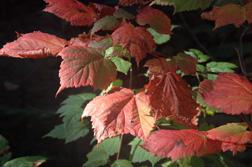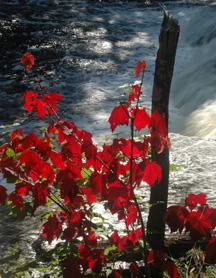Red Maple
- Share
- Tweet
- Pin
- Share

A close-up of Red Maple leaves. Photo by Roy Lukes.
My dad planted a Schwedler Norway Maple in our front yard around 70 years ago. It was an extremely hardy fast-growing tree, and my dad claimed that nearly every seed of the tree that dropped to the ground, or was carried to various places on our large lot, sprouted. He pulled them out by the hundreds. The leaf color in fall was yellow, in a sense a let-down when compared to the brilliant orange-red Sugar Maples elsewhere on our property. Eventually one large branch on the Schwedler broke off and my dad decided to cut the tree, somewhere between 30 and 40 years old, down.
Today, having developed so much fondness for the Red Maple, I wish it had been his choice instead of the Schwedler. Surely the Red Maple, known for its numerous good qualities and especially its gorgeous fall color, would still be standing and bringing great satisfaction into the lives of the people who now own our family home. The tough Red Maple not only has the widest tolerance to climatic conditions of all North American maples, it also has the most widespread range of all maples on our continent.
I’ve had many occasions during the past 46 years of living in Door County to chat with and present programs to what we and others refer to as the “leaf peepers,” visitors from other areas who are bussed or drive here to enjoy the fall change of tree colors. Surely some yellow, such as on Paper Birches, Norway Maples or Aspens, add to the overall panorama of color, but it’s the brilliant reds of the Red Maples, Oranges of the Staghorn Sumacs and Sugar Maples, and purples and plum colors of the White Ashes that these valued and welcome visitors tend to enjoy the most.
Few of the broad-leaved trees of eastern North America are as abundant and widespread as the Red Maple, Acer rubra (A-sir rue-bra), also known as the Soft, Swamp or Scarlet Maple. We have observed more Reds as one drives northward into the Upper Peninsula of Michigan. Several times within the past dozen years we’ve stood along the south edge of the top of Brockway Mountain, immediately south of Copper Harbor, and were thrilled during the last week of September and into early October at what both of us felt was the most gorgeous panorama of absolutely blazing fall tree color to be seen in the Upper Midwest. My estimate is that half or more of the most intense scarlet-red color has been that of the Red Maples.

A Red Maple tree in a sculpture garden. Photo by Roy Lukes.
Yes, the Red Maple is fairly common in Door County. In fact one of the largest of all the trees our “tree” group has measured and recorded is a gigantic Red Maple growing in the Whitefish Dunes State Park along the hiking trail leading to the south shore of Clark Lake. That tree, along the north side of the trail and a few hundred yards south of the lake, is around 12 feet 9 inches in circumference (at 4 ½ feet above the ground) and is a very lofty 88 feet tall. The state record Red Maple is 13.6 feet in circumference and 75 feet tall.
How large can Red Maples get to be in North America? The national record today grows in the Great Smoky Mountain National Park and is 23 feet in circumference and stands 141 feet tall! What a gigantic monument of a “must-see-some-day” tree that is!
Examine a Red Maple throughout the seasons, winter included, and this tree surely lives up to its name. Its leaves in October can be a “trumpet-red” that literally shouts at you, and the petioles (stems) of the leaves are also red as are the tree’s twigs. A January snowshoe trip to examine your favorite Red Maple will reveal its red buds, while a spring May Day hike will thrill you with the tree’s brilliant but tiny red flowers. Come late June or early July, the very small winged seeds, brilliant as a cock’s comb, will also announce their redness.
The leaves, which usually have three triangular lobes, are small for a maple. They are green in summer, red to scarlet in fall and always are whitish below. As is true with Sugar Maples as well, it’s the amount of sunlight along with the type of soil and moisture conditions that bring about the brightest colors. The more sunny days, the richer will be the colors.

A Red Maple next to Tahquamenon Falls. Photo by Roy Lukes.
Another fascinating feature of the Red Maple is that their tiny red winged seeds, called samaras (SAM-a-ras), can ripen as early as late May, fall to the ground and germinate immediately. It is not uncommon to see small Red Maple seedlings by September or early October, about the time our Sugar Maples first drop their samaras. By the way, if you do decide to purchase and plant a Red Maple on your property, consider one of the dazzling cultivars such as the Scarlet Red Maple, Summers Red or Autumn Blaze.
Charlotte and I returned several days ago from a brief camping trip to one of our most favorite regions in the Midwest, the area generally between the northern shores of Lake Michigan, near Gulliver, north to the southern shores of Lake Superior, and from Grand Marais west to Munising. An exciting hike this time took us into the northern mixed hardwoods adjoining the famous and quite awesome Grand Sable Dunes area, at the very eastern end of the Pictured Rocks National Lakeshore several miles west of Grand Marais. A feature of those woods we especially enjoyed was seeing the four species of native maple trees there, the Sugar, Mountain, Red and Striped, all existing nicely together in the same woods. We are very familiar with the first three, but the latter, the Striped, is quite at home in those cool woods but not in our region to the south, although a few small specimens have been found in eastern Door County on some protected property of The Nature Conservancy.
The maples in fall are said to have the most beautiful and varied foliage of all the broad-leaved trees, there being around 115 maple species in the Northern Hemisphere. In our region it’s the Red Maple which has proven to be such an outstanding ornamental tree, excellent for residential or park landscaping. Here is a tree that is beautiful at all ages and in all seasons.
